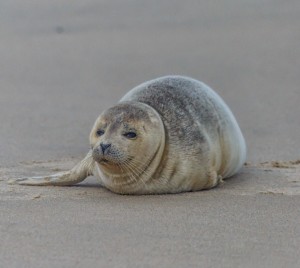
OCEAN CITY — The first batch of migrating seals on the beaches in and around the resort were reported this week, providing an opportunity to remind curiosity seekers and photographers to observe and enjoy the annual visitors from a safe distance as they move through the area as part of their natural migration process.
National Aquarium Marine Animal Rescue Program Stranding Coordinator Jenn Dittmar confirmed this week there had been four sightings on the beaches in Ocean City since Monday, signaling the annual appearance of the popular seals each winter.
“We’ve seen at least four individual seals since Monday and all of them thus far have been harbor seals,” Dittmar said this week. “All have been reported on the Atlantic side beaches and all of them have been in good body condition.”
Dittmar said the four reported this week were all observed on the beach in the north end of Ocean City. However, Assateague Island National Seashore Science Communicator Kelly Taylor said this week a handful have also been seen in and around the barrier island, including one spotted bobbing in the Inlet on Wednesday.
For the next several weeks, seals of various species and sizes will appear on the beaches throughout the mid-Atlantic area and on rocks, piers and docks along the bayside. For the most part, the seals are typically healthy and just resting and sunning themselves on the beach or on jetties, docks and piers before moving along in their migration. In some cases, the seals are injured or ill and require rescue and rehabilitation from the MARP program and its volunteer network. However, those spotted thus far this week have been healthy and showed no signs of illness or injury.
“Typically this time of year, they’re just starting their migrations and they are fit and healthy and just resting on their stopovers here,” said Dittmar. “Later in the season, we might see more that are in need of rescue or assistance because they are on their return journey and have traveled great distances.”
With the return of seals along the coastline in the resort area will be an in-kind number of curiosity seekers and photographers intent on interacting with the visitors. However, Dittmar this week reiterated the importance of observing from a safe distance and protecting and preserving their privacy.
“If you’re lucky enough to see a seal on the beach, it’s best to give the animal at least 100 feet of space and, if possible, stay downwind,” she said. “Enjoy watching our seasonal visitors from a distance and take plenty of photos and videos, but please try not to disturb them as they still have a long journey ahead of them.”
Dittmar said healthy seals can usually be observed resting in a “banana” position on their side with their heads or rear flippers in the air. An injured, ill or entangled seal will often be seen resting flat on its stomach. Anyone observing a seal that may be in need of medical attention can call the National Aquarium’s Stranding Hotline at 410-373-0083, or the Maryland Natural Resources Police (NRP) at 800-628-9944. The Maryland Coastal Bays Program also has a link for reporting seal sightings on its website at mdcoastalbays.org.
